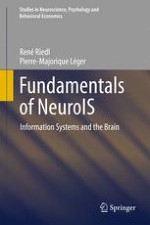2016 | OriginalPaper | Buchkapitel
3. Tools in NeuroIS Research: An Overview
verfasst von : René Riedl, Pierre-Majorique Léger
Erschienen in: Fundamentals of NeuroIS
Verlag: Springer Berlin Heidelberg
Aktivieren Sie unsere intelligente Suche, um passende Fachinhalte oder Patente zu finden.
Wählen Sie Textabschnitte aus um mit Künstlicher Intelligenz passenden Patente zu finden. powered by
Markieren Sie Textabschnitte, um KI-gestützt weitere passende Inhalte zu finden. powered by
